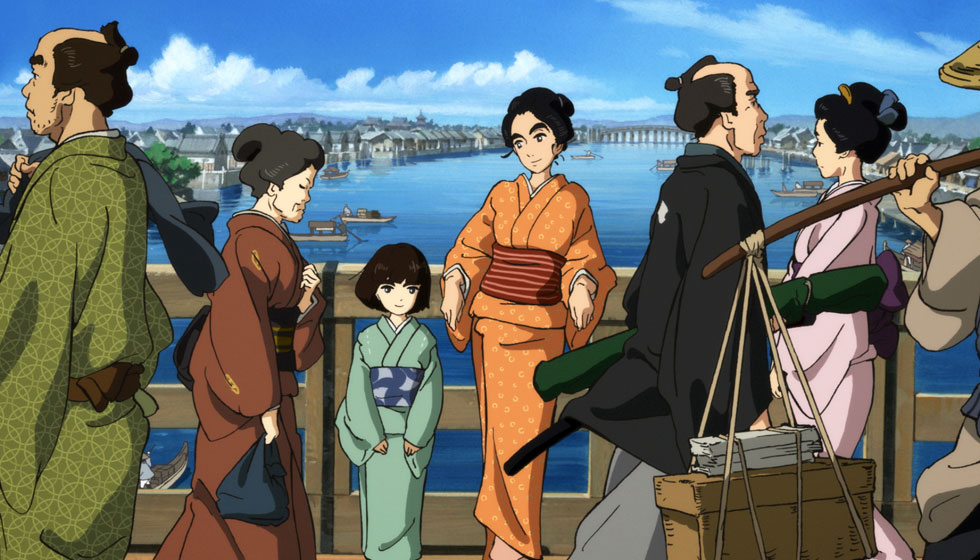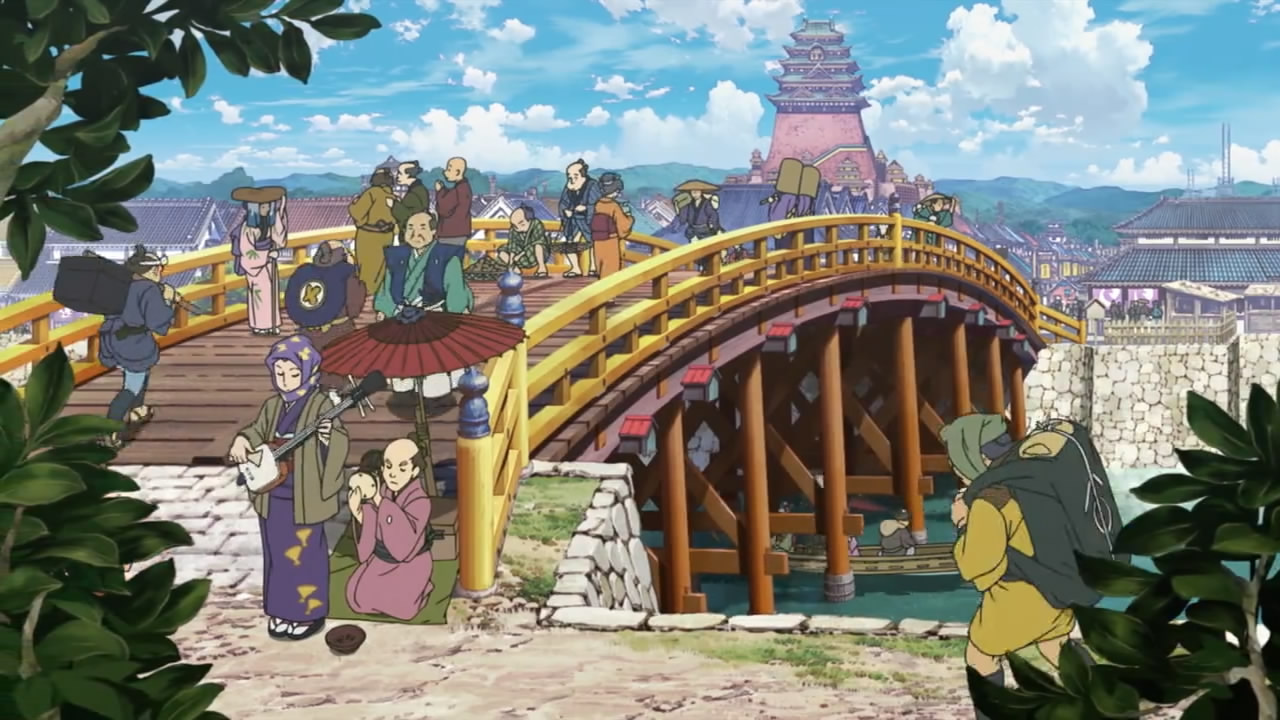Visions of Edo
March 7, 2016 · 0 comments
Andrew Osmond takes a step into the past.
Thanks to cinema and TV, some long-ago places can feel closer to us than most present-day countries. For British people, one of the closest is Victorian England, specifically Victorian London, home to Dickens dramas, Sherlock mysteries, Martian invasions and the gory mythos of Jack the Ripper.
This spring, though, has given us the chance to explore another 19th-century city through two different anime films. Miss Hokusai and Fuse: Memoirs of the Hunter Girl both take place in Edo – that is to say Tokyo, before the city was so named in 1869. Edo became Tokyo after the Meiji Restoration, a watershed in Japanese history. Before then, Japan was ruled by the Edo-based Tokugawa Shogunate, a feudal government that had been in power since the 1600s. The Meiji Restoration marked the time when the Shogun gave way to the Emperor in 1868. The following year, the Meiji Emperor moved from Kyoto to Edo and renamed it Tokyo, the new capital city.
Neither Miss Hokusai nor Fuse are about the Meiji Restoration. But they’re both set in a Tokugawa Japan whose days are ending, and both films implicitly look forward to the great changes to come. The Restoration was more than a regime change. It confirmed that Japan, isolated and secretive for so long, would finally open up to the Western world. Miss Hokusai is largely about Hokusai, the painter who would become one of Japan’s ambassadors to the West through his wonderful art. His pictures would inspire Van Gogh, Monet and Degas, and suggest revolutionary new ways to express the world… though Hokusai himself was dead by then.
In Fuse, the foreshadowing of change is more upfront, the dramatic irony laid on thick. More than one character says that the Tokugawa regime looks mighty secure… and yet, we’re shown the Shogun himself, Iesada Tokugawa, a sickly, neurotic youth who’s terrified of the future, paranoid that his own power might be fake or “counterfeit.” There are script references to the new in Japan – the Black Ships of Matthew Perry had sailed into Japan in 1853, rocking the Shogun government. You can see Fuse’s fantastical story, about werewolves causing panic in Tokyo, as an allegory for how the Japanese feared foreign devils.
 Miss Hokusai and Fuse are set several decades apart; Miss Hokusai in 1814, and Fuse somewhere between 1853 (when the Black Ships arrived) and 1858 (when Iesada died). Both highlight the fabled red-light district of Yoshiwara, a district of thousands of prostitutes. In both Fuse and Miss Hokusai, Yoshiwara conceals dangerous, sexy supernatural secrets, reflecting the district’s alluring image. The real O-Ei, Hokusai’s daughter, may have contributed to the legend through her famous painting, Night Scene in the Yoshiwara.
Miss Hokusai and Fuse are set several decades apart; Miss Hokusai in 1814, and Fuse somewhere between 1853 (when the Black Ships arrived) and 1858 (when Iesada died). Both highlight the fabled red-light district of Yoshiwara, a district of thousands of prostitutes. In both Fuse and Miss Hokusai, Yoshiwara conceals dangerous, sexy supernatural secrets, reflecting the district’s alluring image. The real O-Ei, Hokusai’s daughter, may have contributed to the legend through her famous painting, Night Scene in the Yoshiwara.
Of the two films, Fuse presents a more luridly exaggerated version of Yoshiwara, dominated by a giant nude female statue. Yet it also acknowledges the dark side of the district, where dead girls and babies fetch up in a noisome ditch. To make a British analogy, the myths of Yoshiwara may not be so far from the myths of nineteenth-century Whitechapel. Many fictionalised versions of the “Jack the Ripper” story show Mary Kelly and the Ripper’s other prey as glamorous, alluring temptresses, when the reality was very different.
 Visually, Miss Hokusai’s rendering of Edo is more conventionally realistic. Animated by Production I.G, Miss Hokusai feels in the mould of the studio’s Moribito: Guardian of the Spirit (set in an Asian-medieval style fantasy realm) or even I.G’s anime set in modern or future Tokyo. Miss Hoksusai has some scenes in the supernatural world, which seems to exist alongside the human one, but these still feel separate from everyday Edo life. Fuse, animated by Tokyo Movie Shinsha, is different, and not just because it puts fantastical monsters right at the centre of Edo. It also feels more impressionistic and cartoonish; its presentation recalls a different I.G history drama, Giovanni’s Island.
Visually, Miss Hokusai’s rendering of Edo is more conventionally realistic. Animated by Production I.G, Miss Hokusai feels in the mould of the studio’s Moribito: Guardian of the Spirit (set in an Asian-medieval style fantasy realm) or even I.G’s anime set in modern or future Tokyo. Miss Hoksusai has some scenes in the supernatural world, which seems to exist alongside the human one, but these still feel separate from everyday Edo life. Fuse, animated by Tokyo Movie Shinsha, is different, and not just because it puts fantastical monsters right at the centre of Edo. It also feels more impressionistic and cartoonish; its presentation recalls a different I.G history drama, Giovanni’s Island.
However, Fuse has a more straightforward story. At least on the surface, it’s telling a simple mystery-adventure (plus a love story) with a clear start and finish. Miss Hokusai goes for a looser, episodic narrative that’s drawn some criticism. Both films allude to other (real) works. Most viewers of Miss Hokusai will surely spot the moment when a wave lifts up a boat in the manner of Hokusai’s best-known painting, The Great Wave off Kanagawa. Fewer Western viewers will appreciate how Fuse reworks and comments on another nineteenth-century masterpiece, the epic serial The Hakkenden by Kyokutei Bakin.
We talked about Fuse’s relationship with The Hakkenden in a previous article, which also mentioned another link between the films. Both Miss Hokusai and Fuse depict women in the shadows of male creators; O-Ei in Miss Hokusai, who’s the daughter of the great painter himself, and Meido in Fuse, granddaughter of Bakin. (On the face of it, Meido is a supporting character in Fuse, but if you watch the film closely, you’ll see she’s fundamental to the story.) Both women learn from their patriarchs: neither are constrained by them.
The Miss Hokusai characters, though, are constrained – by their society. Talking to MyM magazine, director Keiichi Hara explained, “In the value-system of the Edo period, there are two words, iki and yabo. Iki is chic and refined; it involves not being overly expressive, not making a fuss about things.” This was the character type that Hara aimed to depict in Miss Hokusai. “Yabo is the opposite, meaning going over the top, expressing yourself too much, which wasn’t the done thing in the Edo period.”
In contrast to Miss Hokusai, the characters in Fuse are most definitely yabo. They act, react and overact like cartoon characters, not like players in a refined period drama. Perhaps that’s the deepest difference between Miss Hokusai and Fuse. The former film aims to be an animation rather than a cartoon, a drawn drama with a few cartoony bits. For its part, Fuse is an all-out cartoon; however, it aims to be a smart cartoon.
Fuse: Memoirs of the Hunter Girl is released in the UK by Anime Ltd. Miss Hokusai is currently on tour with the Japan Foundation cinema programme.
animation, anime, Edo, Fusé, Japan, Japan Foundation, Keiichi Hara, Masayuki Miyaji, Memoirs of a Huntress, Memoirs of the Hunter Girl, Miss Hokusai, Tokyo

Leave a Reply